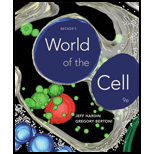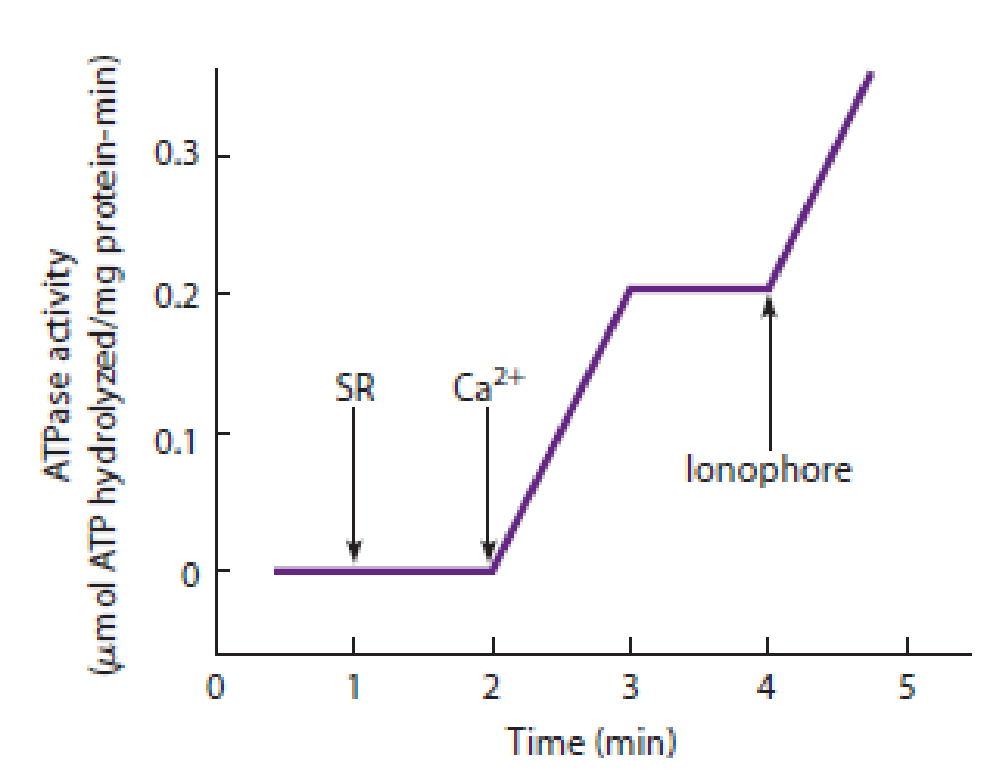
Concept explainers
QUANTITATIVE The Calcium Pump of the Sarcoplasmic Reticulum. Muscle cells use calcium ions to regulate the contractile process. Calcium is both released and taken up by the sarcoplasmic reticulum (SR). Release of calcium from the SR activates muscle contraction, and ATP-driven calcium uptake causes the muscle cell to relax afterward. When muscle tissue is disrupted by homogenization, the SR forms small vesicles called microsomes that maintain their ability to take up calcium. To obtain the data shown in Figure 8-17, a reaction medium was prepared to contain 5 mM ATP and 0.1 M KCl at pH 7.5. An aliquot of SR microsomes containing 1.0 mg protein was added to 1 mL of the reaction mixture, followed by 0.4 mmol of calcium. Two minutes later, a calcium ionophore was added. (An ionophore is a substance that facilitates the movement of an ion across a membrane.) ATPase activity was monitored during the additions, with the results shown in the figure.

Figure 8-17 Calcium Uptake by the Sarcoplasmic Reticulum. See Problem 8-10.
- (a) What is the ATPase activity, calculated as micromoles of ATP hydrolyzed per milligram of protein per minute?
- (b) The ATPase is calcium-activated, as shown by the increase in ATP hydrolysis when the calcium was added and the decrease in hydrolysis when all the added calcium was taken up into the vesicles 1 minute after it was added. How many calcium ions are taken up for each ATP hydrolyzed?
- (c) The final addition is an ionophore that carries calcium ions across membranes. Why does ATP hydrolysis begin again?
Want to see the full answer?
Check out a sample textbook solution
Chapter 8 Solutions
Becker's World of the Cell (9th Edition)
- If you had an unknown microbe, what steps would you take to determine what type of microbe (e.g., fungi, bacteria, virus) it is? Are there particular characteristics you would search for? Explain.arrow_forwardavorite Contact avorite Contact favorite Contact ୫ Recant Contacts Keypad Messages Pairing ง 107.5 NE Controls Media Apps Radio Nav Phone SCREEN OFF Safari File Edit View History Bookmarks Window Help newconnect.mheducation.com M Sign in... S The Im... QFri May 9 9:23 PM w The Im... My first.... Topic: Mi Kimberl M Yeast F Connection lost! You are not connected to internet Sigh in... Sign in... The Im... S Workin... The Im. INTRODUCTION LABORATORY SIMULATION Tube 1 Fructose) esc - X Tube 2 (Glucose) Tube 3 (Sucrose) Tube 4 (Starch) Tube 5 (Water) CO₂ Bubble Height (mm) How to Measure 92 3 5 6 METHODS RESET #3 W E 80 A S D 9 02 1 2 3 5 2 MY NOTES LAB DATA SHOW LABELS % 5 T M dtv 96 J: ப 27 כ 00 alt A DII FB G H J K PHASE 4: Measure gas bubble Complete the following steps: Select ruler and place next to tube 1. Measure starting height of gas bubble in respirometer 1. Record in Lab Data Repeat measurement for tubes 2-5 by selecting ruler and move next to each tube. Record each in Lab Data…arrow_forwardCh.23 How is Salmonella able to cross from the intestines into the blood? A. it is so small that it can squeeze between intestinal cells B. it secretes a toxin that induces its uptake into intestinal epithelial cells C. it secretes enzymes that create perforations in the intestine D. it can get into the blood only if the bacteria are deposited directly there, that is, through a puncture — Which virus is associated with liver cancer? A. hepatitis A B. hepatitis B C. hepatitis C D. both hepatitis B and C — explain your answer thoroughlyarrow_forward
- Ch.21 What causes patients infected with the yellow fever virus to turn yellow (jaundice)? A. low blood pressure and anemia B. excess leukocytes C. alteration of skin pigments D. liver damage in final stage of disease — What is the advantage for malarial parasites to grow and replicate in red blood cells? A. able to spread quickly B. able to avoid immune detection C. low oxygen environment for growth D. cooler area of the body for growth — Which microbe does not live part of its lifecycle outside humans? A. Toxoplasma gondii B. Cytomegalovirus C. Francisella tularensis D. Plasmodium falciparum — explain your answer thoroughlyarrow_forwardCh.22 Streptococcus pneumoniae has a capsule to protect it from killing by alveolar macrophages, which kill bacteria by… A. cytokines B. antibodies C. complement D. phagocytosis — What fact about the influenza virus allows the dramatic antigenic shift that generates novel strains? A. very large size B. enveloped C. segmented genome D. over 100 genes — explain your answer thoroughlyarrow_forwardWhat is this?arrow_forward
- Molecular Biology A-C components of the question are corresponding to attached image labeled 1. D component of the question is corresponding to attached image labeled 2. For a eukaryotic mRNA, the sequences is as follows where AUGrepresents the start codon, the yellow is the Kozak sequence and (XXX) just represents any codonfor an amino acid (no stop codons here). G-cap and polyA tail are not shown A. How long is the peptide produced?B. What is the function (a sentence) of the UAA highlighted in blue?C. If the sequence highlighted in blue were changed from UAA to UAG, how would that affecttranslation? D. (1) The sequence highlighted in yellow above is moved to a new position indicated below. Howwould that affect translation? (2) How long would be the protein produced from this new mRNA? Thank youarrow_forwardMolecular Biology Question Explain why the cell doesn’t need 61 tRNAs (one for each codon). Please help. Thank youarrow_forwardMolecular Biology You discover a disease causing mutation (indicated by the arrow) that alters splicing of its mRNA. This mutation (a base substitution in the splicing sequence) eliminates a 3’ splice site resulting in the inclusion of the second intron (I2) in the final mRNA. We are going to pretend that this intron is short having only 15 nucleotides (most introns are much longer so this is just to make things simple) with the following sequence shown below in bold. The ( ) indicate the reading frames in the exons; the included intron 2 sequences are in bold. A. Would you expected this change to be harmful? ExplainB. If you were to do gene therapy to fix this problem, briefly explain what type of gene therapy youwould use to correct this. Please help. Thank youarrow_forward
- Molecular Biology Question Please help. Thank you Explain what is meant by the term “defective virus.” Explain how a defective virus is able to replicate.arrow_forwardMolecular Biology Explain why changing the codon GGG to GGA should not be harmful. Please help . Thank youarrow_forwardStage Percent Time in Hours Interphase .60 14.4 Prophase .20 4.8 Metaphase .10 2.4 Anaphase .06 1.44 Telophase .03 .72 Cytukinesis .01 .24 Can you summarize the results in the chart and explain which phases are faster and why the slower ones are slow?arrow_forward
 Biology 2eBiologyISBN:9781947172517Author:Matthew Douglas, Jung Choi, Mary Ann ClarkPublisher:OpenStax
Biology 2eBiologyISBN:9781947172517Author:Matthew Douglas, Jung Choi, Mary Ann ClarkPublisher:OpenStax Human Physiology: From Cells to Systems (MindTap ...BiologyISBN:9781285866932Author:Lauralee SherwoodPublisher:Cengage Learning
Human Physiology: From Cells to Systems (MindTap ...BiologyISBN:9781285866932Author:Lauralee SherwoodPublisher:Cengage Learning Biology: The Dynamic Science (MindTap Course List)BiologyISBN:9781305389892Author:Peter J. Russell, Paul E. Hertz, Beverly McMillanPublisher:Cengage Learning
Biology: The Dynamic Science (MindTap Course List)BiologyISBN:9781305389892Author:Peter J. Russell, Paul E. Hertz, Beverly McMillanPublisher:Cengage Learning Biology Today and Tomorrow without Physiology (Mi...BiologyISBN:9781305117396Author:Cecie Starr, Christine Evers, Lisa StarrPublisher:Cengage Learning
Biology Today and Tomorrow without Physiology (Mi...BiologyISBN:9781305117396Author:Cecie Starr, Christine Evers, Lisa StarrPublisher:Cengage Learning Human Heredity: Principles and Issues (MindTap Co...BiologyISBN:9781305251052Author:Michael CummingsPublisher:Cengage Learning
Human Heredity: Principles and Issues (MindTap Co...BiologyISBN:9781305251052Author:Michael CummingsPublisher:Cengage Learning





